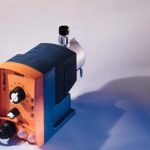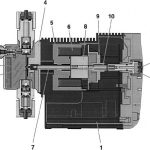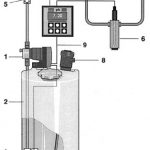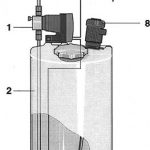The solenoid-driven metering pumps in the beta series are tailored to the needs of the water treatment industry, while also lending themselves to applications in many other branches of industry. The pumps are easily integratable into centrally controlled processes, slotting into the growing trend towards automation.
Rainer Dulger, Michael Rummer
The beta solenoid-driven metering pumps consist of two main components: the pump drive and the liquid end. As shown in Figure 2, the pump drive comprises a housing, a solenoid with a thrust piece and a solenoid axle with a stroke adjustment knob and an electronic control unit with user interface elements. The liquid end is made up of a dosing head with pressure and suction valves, a diaphragm and a back plate. The pump action is pulsed: for each electronic impulse, a magnetic field is generated in the solenoid coil, and the movable thrust piece is drawn towards the dosing head until contact is made. The diaphragm is moved forwards over the fixed solenoid axle, forcing the dosing chemical through the pressure valve and out of the dosing head – the suction valve remains closed at this point. As soon as the impulse current to the solenoid is interrupted, the magnetic field is broken, and the thrust piece, along with the diaphragm, is moved back by a spring towards its initial posi-tion. At the same time the pressure valve closes and the dosing head is refilled via the suction valve. The thrust piece is the only moving part of the solenoid drive. It is usually encased in a virtually indestructible PTFE housing, which is why solenoid drives are frequently described as “maintenance-free”.
The adjustment of the metering volume is carried out by limiting the reciprocal stroke using the stroke adjustment screw. On the solenoid-driven diaphragm pumps the thrust bearing for the stroke adjustment screw is rigidly attached to the solenoids. This ensures that the impact of the thrust piece on the suction strokes is intercepted by the solenoid and does not affect the electronic control unit. In addition, when the housing is opened on site there is no need to readjust the stroke length zero-point. The metering volumes should be adjusted while the pump is running, as the stroke adjustment screw is freed for a short period during the pressure stroke.
The liquid end is hermetically sealed by the diaphragm, which is held under tension between the dosing head and the back plate. The side of the diaphragm which comes into contact with the dosing chemical is coated with PTFE, which guarantees good chemical resistance and mechanical strength. The carrier material is a fabric-reinforced EPDM elastomer with a steel core, which is screwed onto the magnetic axle. At the maximum stroke length of 1.25 mm the flexing zone can be kept to a minimum, thus achieving a high pressure resistance.
Capacity range
The beta pump series is offered in two sizes: the beta/4 for a capacity of 0.6 to 20 l/h and the beta/5 for a capacity of 4.7 to 32 l/h at back pressure of 16 to 2 bar.
Entire pump systems can be assembled from a combination of two drive units and eight liquid ends of different sizes. Dealers benefit from the fact that both the liquid ends and the drive units in the beta/4 series and the drive units in the beta/5 series are interchangeable, which means that by stocking only a few components, the entire capacity range is covered. Short delivery times can be guaranteed, without the need for high storage costs. The final programming of capacity data allows the operator to limit the pressure which can build up against a closed valve or clocked dosing pipe during pump operation.
Adjustment and control options
The capacity of the beta is determined by the stroke length and the stroke frequency. The stroke length can be adjusted to any value between 0 and 100%. As there is an approximately linear relationship between the pump capacity and these two parameters, the pump adjustment can be optimally adapted to the process. To obtain thorough mixing, a high stroke frequency and a reduced stroke length are recommended. If the dosing chemical is viscous or gaseous, a longer stroke length and a reduced stroke frequency are recommended.
Alongside manual stroke frequency adjustment, the beta series offers a number of external control options.
The remote ON/OFF switch function allows the pump to be switched on and off via a de-energised contact. As long as the control contact is closed, the pump will operate at the frequency set with the multi-function knob. If the control contact is opened, the pump eases operation. In case of a break in the cable, the “Life Zero” mode stops the pump operation, so that no further dosing takes place.
During external operation with the de-energised contact the stroke frequency of the pump is set by means of a separate controller. The typical applications for this mode include quantity-proportional distribution of chemicals into potable water.
The function switch for changing from external frequency to auxiliary frequency allows pumps to be switched to the maximum frequency via a voltage-free contact. This operating mode overrides both the manual and external operating modes. Remote controlled suction or shock-dosing, e. g. during the disinfection of cooling water, can be achieved in this way. This function operates according to a continuous-flow principle, guaranteeing the greatest possible safety against the occurrence of undesirable dosing due to cable failure.
A two-stage level switch can be installed for monitoring chemical containers. When the chemical levels reach the first switch level, the pump outputs a warning signal, and the optional fault-indicating relay is energised. This allows the operator sufficient time to refill the chemical container before the chemical levels reach the second switch level, causing the pump to stop operating.
The right liquid-end material for every chemical
The multiple application options of the beta diaphragm metering pumps demand a range of liquid-end materials suitable for the various tasks. Polypropylene is cost-effective, offers good chemical resistance and is suitable for the majority of chemicals used in the water treatment industry. The material combination of acrylic and PVC is predominantly used for dosing sodium or calcium hypochlorite. In addition to its excellent chemical resistance, it has the advantage that acrylic is transparent and allows observation and monitoring of the pump process. Any deposits of air caused by, for example, operational interruptions, can be rapidly recognised and removed. For metering highly concentrated acid and alkaline solutions, there are liquid ends made of PTFE.
This material is resistant to practically all chemicals used in process technology. Stainless-steel liquid ends are used in the chemical/pharmaceutical and food-and-beverages industries. They are resistant to organic solvents and can be sterilised.
Self-bleeding dosing heads, which are available in polypropylene or acrylic/PVC, are recommended for very gaseous chemicals such as hydrogen peroxide or peracetic acid.
General-purpose, safe and economical
In the beta solenoid-driven diaphragm metering pumps the liquid end is hermetically sealed from the surrounding atmosphere by a PTFE-coated elastomer diaphragm. The combination of air-tightness and good chemical resistance is an ideal solution for metering disinfectant chemicals, e. g. sodium or calcium hypochlorite, pH correction chemicals or hazardous chemicals which should not come into contact with the surrounding atmosphere (e. g. hydrazine). Rinsing equipment and bunds are not required; liquids under anti-septic conditions for which it must be possible to CIP the entire plant, e. g. by means of hot-steam process chemicals that are sensitive to atmosphere, if contact with the environment must be avoided, e. g. water glass. The beta solenoid-driven diaphragm metering pumps have no dynamic seals and therefore do not leak. This means that there is no need to install equipment to prevent dry running. In conjunction with the practically wear-free solenoid drive, users will find themselves equipped with a most reliable, safe and altogether cost-effective metering system. With the many available control options, this system can be used for practically any task within the field of water treatment, and also integrated into larger process technology systems.
ProMinent
Fax: ++49/6221/842-220
Further information cpp 239
Unsere Webinar-Empfehlung
Die Websession „Wasserstoff in der Chemie – Anlagen, Komponenten, Dienstleistungen“ (hier als Webcast abrufbar) zeigt technische Lösungen auf, die die Herstellung und Handhabung von Wasserstoff in der chemischen Industrie sicher machen und wirtschaftlich gestalten.
Ob effizienter…
Teilen:














